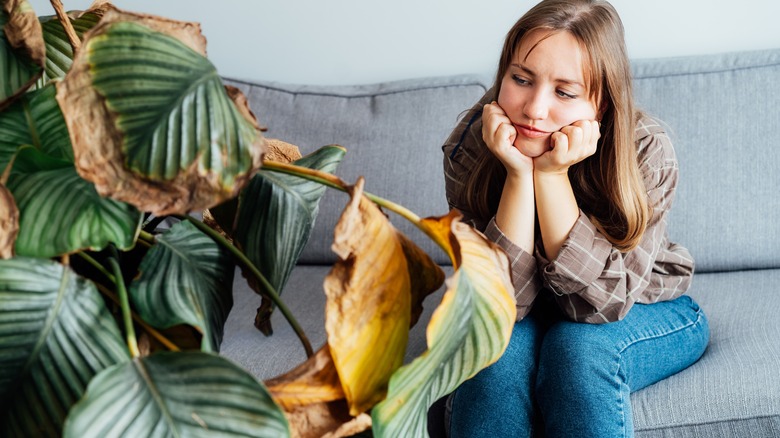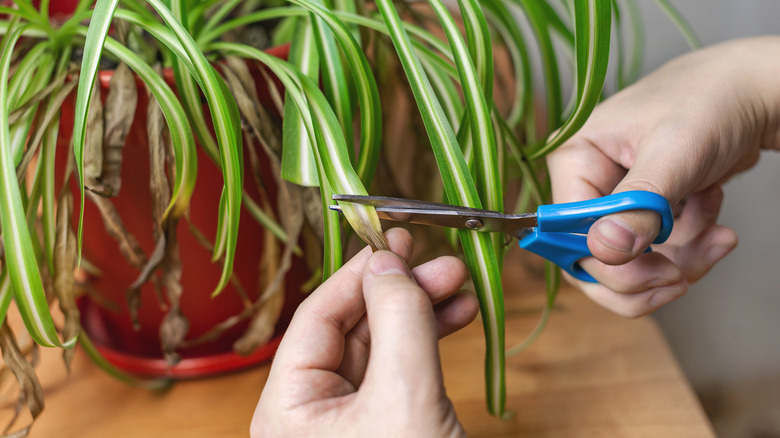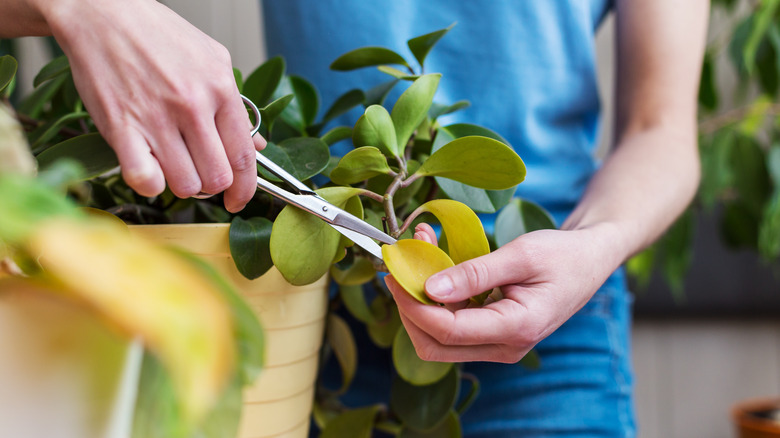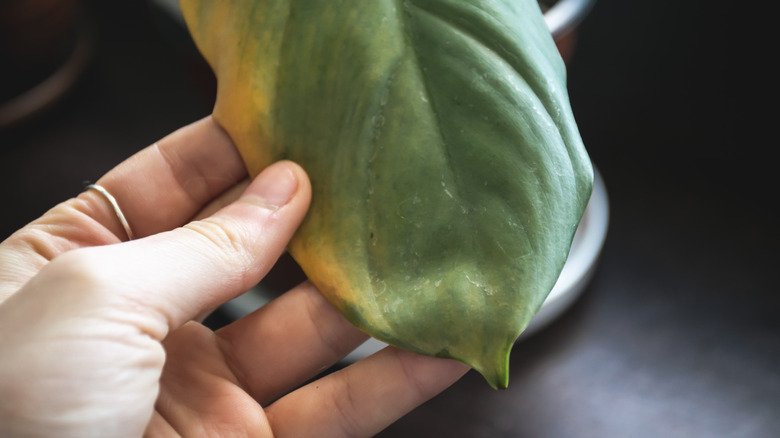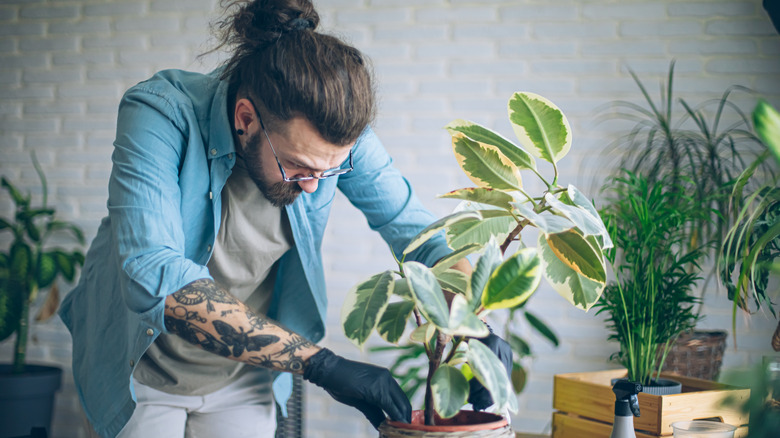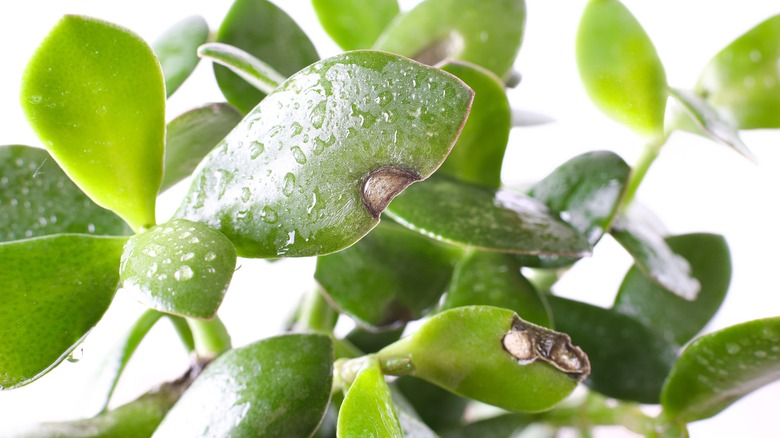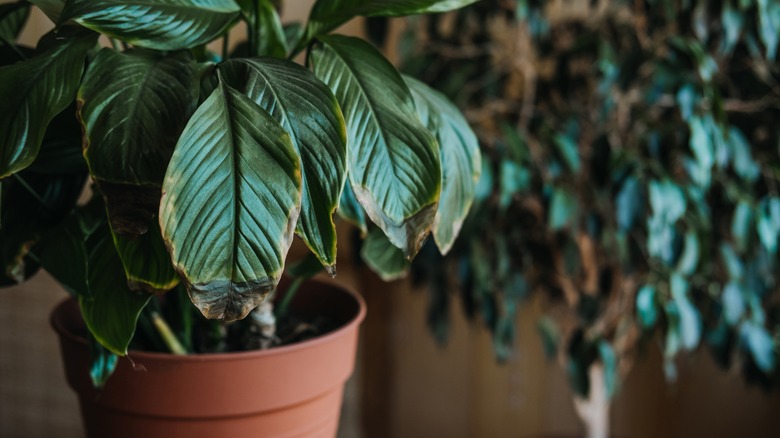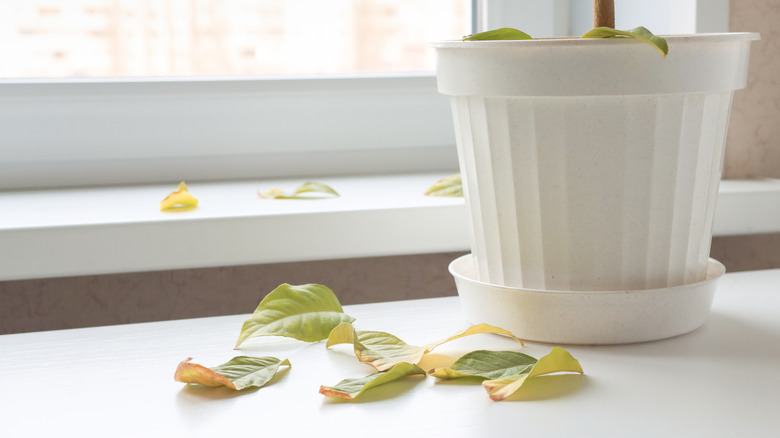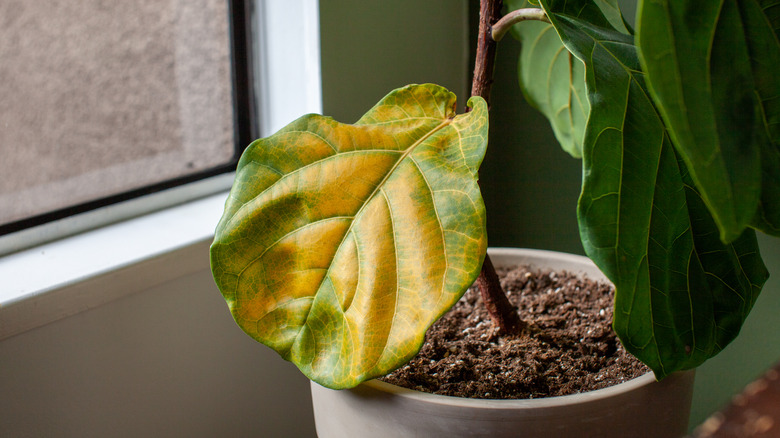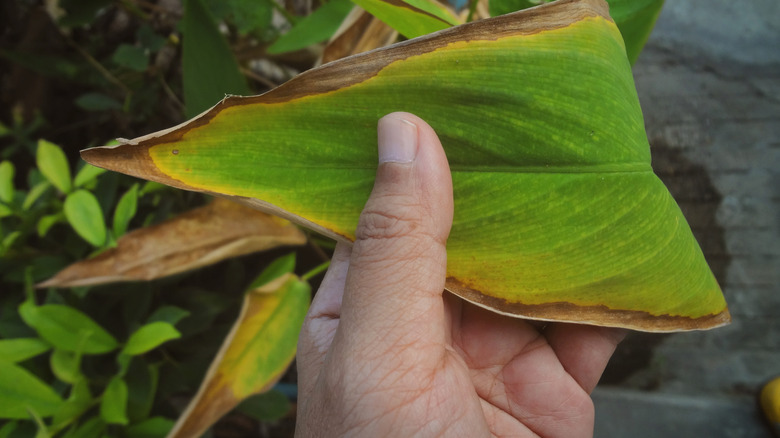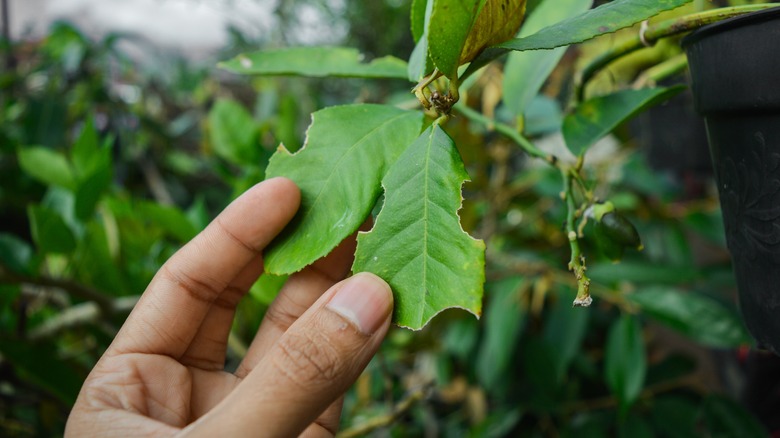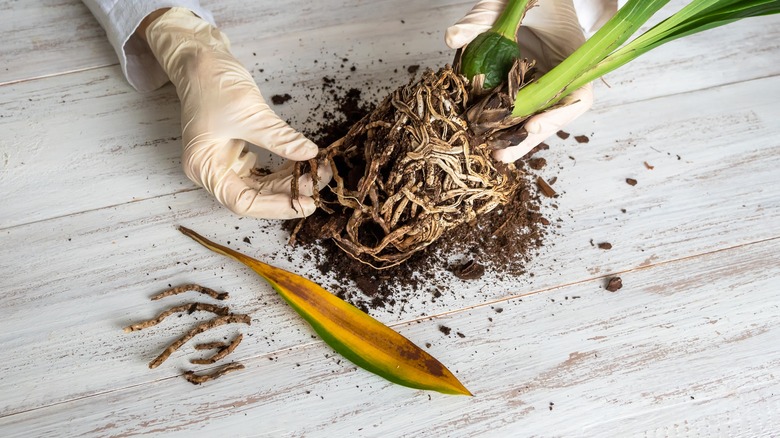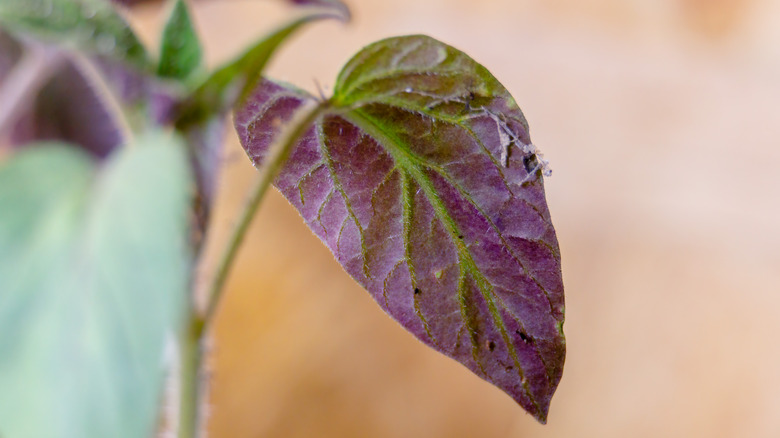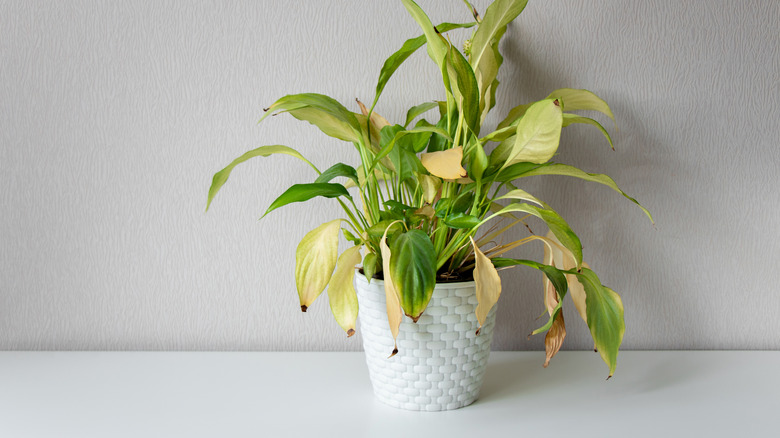13 Crucial Things Your Houseplants' Changing Leaves Are Trying To Warn You About
Houseplants allow you to bring a touch of the outdoors inside, especially if you set them up to grow and thrive. This can take time to learn how to do, but it's a rewarding project. Even though there are several things that can go wrong with your plants, they're also good at giving you visual cues that they need attention. If you notice the foliage turning brown or yellow, or even red, purple, or black, this is a sign that something is wrong. Taking steps to determine what's making your plants unhealthy and addressing the issue will keep them happy.
While the foliage gives you visual cues that something is amiss, it can be easy to overlook the warning signs until your plant starts to drop leaves, wither, and eventually die. To make it more complicated, there are several things your plant's foliage can do, and each has a different cause and way to fix it to make your plant healthy again.
Whether your houseplants have yellow leaves, spotted or brown edges, or are wilting, addressing the root cause as quickly as possible gives your plants the best chances for survival. Some of these warning signs are relatively easy to fix, while others may require you to cut out rotted parts to save the plant. However, this is all part of caring for your plants and nurturing thriving green spaces indoors.
Brown leaf tips indicate underwatering or low humidity
If your plant's leaves tips start to turn brown, this usually tells you there is some type of stress point. Usually, it indicates that the indoor humidity is too low or you're not watering enough. It's common to see the edges of your spider plant leaves turning brown, and it's also a big problem with dracaena. Not watering enough stops the plant from keeping a healthy cell structure, making the edges and tips change color. Low humidity makes more water evaporate from the foliage, worsening the drying effect. Browning is your plant's response to being stressed because it's not getting enough water from the surrounding air or roots.
To fix this problem, Iowa State University recommends increasing your relative humidity and adjusting your watering routine. When you give your plants a drink, put them in the bathtub or sink and run water until it comes out of the drainage holes. This ensures it soaks the roots and drains the excess so root rot doesn't take hold. For low humidity, put a pebble tray with water under your plant's container, increasing the humidity levels directly around the plant as it evaporates or mist the leaves daily. Another option is to put a humidifier in the room to make it more humid, keep your houseplants healthy, and prevent stress points.
The entire plant is turning yellow and wilting from chemical burns
When the whole plant takes on an unhealthy yellow color and starts to wilt, Texas A&M says chemical burns are a common culprit, usually due to too much fertilizer or herbicide exposure. Chemical burns happen when your plants get overloaded with chemical substances, damaging their tissues. As the burns happen, your plant will wilt and turn greenish-yellow. Fertilizer also has salt, which can build up in the soil with repeat applications. When this happens, it dehydrates the houseplants and makes them more prone to infections by weakening them. Also, accidentally splashing or spraying herbicide on them will cause damage and plant death.
If you accidentally over-fertilize your houseplants, you can help them survive chemical burns by flushing the soil. Put your planters in the sink under running water, allowing them to drain through the bottom for several minutes. This will dilute the chemicals and salt in the soil to stop them from hurting your plant. Also, don't add fertilizer until your plant recovers from the original chemical exposure. Keep any herbicides and chemicals away from your houseplants to stop any accidental exposure going forward.
Pale leaves mean a lack of light
When your houseplant leaves turn a pale green or yellow, PennState Extension says this usually means they need more light. Plants use lights to photosynthesize, and this is where they create the sugar they need to grow and stay healthy. Light exposure dictates how much chlorophyll (green coloring) is in the leaves. If they don't get enough, they make less chlorophyll, causing the colors to be much lighter and less vibrant. They could be too far away from the light like a window, or other objects could shade them. This coloring tells you your plant can't photosynthesize correctly, and this can stunt its growth.
If low light is the problem, look for a spot in your home that gives it more natural light. An area by an east-facing window will give it an indirect but bright light for several hours daily. Direct light, especially during the hottest parts of the day, can scorch the leaves. If your space has limited natural light, installing artificial grow lights is an excellent alternative. They give your plants a consistent light source to help them keep the healthy green coloring. For grow lights, follow the directions on how long to have them on and how high to put them above your plants to avoid damaging the foliage.
Sticky leaves hint at a pest infestation
Are the leaves of your plant getting sticky? It's possible that pests like mealybugs, aphids, or scale insects are to blame if this is the case. They eat the sap from your plants because they are full of sugar and nutrients. When they eat, they excrete honeydew, and this is a very sticky residue that sits on the foliage. Pests can quickly infect other plants and make it possible for sooty mold to grow, which is a black fungus that covers the leaves. Pests can also slow the plant's growth by taking its nutrients.
To save your plants, you must act quickly when you see pests. Put your plants in the sink or bathroom and quickly spray them with a steady stream of warm water. This will help get rid of the bugs on the leaves. Severe infestations mean you isolate your houseplant and put an insecticidal soap onto any affected foliage to kill the bugs and safeguard your plant. Carefully follow the instructions on the package for the best results to take care of current pests and any unhatched eggs. Also, Clemson Cooperative Extension says to make a point to inspect all of your houseplants every week or so, looking at the undersides of the foliage to catch pests early because prevention is critical to keeping your plants thriving.
Spots on leaves hint at fungal infections or pests
Seeing black or brown spots on the foliage is a very clear sign that your plant may have an issue with pests or fungal infections. These patches come from fungi getting on and then into the leaf tissue and breaking it down or by pests feeding on the foliage, leaving spots behind. Seeing these spots tells you that your houseplants aren't healthy, and you want to take immediate steps to eliminate the pests or infections. Working fast is critical because the fungal spores thrive in various conditions, and pests are attracted to stressed or weak plants and can quickly kill the plant.
To get rid of white mold, pests, or other fungal infections, take the infected plant and quarantine it so the issue doesn't spread to your other healthy plants. Once it's by itself, figure out how bad the problem is. Apply a fungicide directly to the area, and ensure it's designed to kill the type of fungus on your plant. For pests, treat the plant with an insecticidal soap or neem oil. These products kill a range of pests without hurting your plant or making it weaker. Remove any severely damaged leaves to stop the fungus or pests from spreading to the rest of the plant and encourage new, healthy growth. To prevent these issues, look your plants over at least weekly and space them out so air can circulate.
Curling leaves mean too much heat or water stress
Your houseplants' leaves can curl as a defense mechanism if it's trying to protect itself from too much heat or water stress. This is a natural response to extreme conditions, so it's common. The University of Nebraska-Lincoln points out that when the plant has high-temperature exposure, the leaves curl to reduce the surface area exposed to the air, reducing water loss. Also, when they're water-stressed, either from too much or too little water, the leaves will curl to help conserve moisture. This is a very visible cue that something isn't right, and you must adjust your care routine.
To make your plant's leaves straighten out, take a look and adjust your plant care practices. Where do you have your plants? Move them to a more protected and shaded area if they're by or in a direct heat source, like air conditioners, radiators, or south-facing windows. If the issue is water stress, get a consistent watering schedule in place. Let the top one to two inches of soil dry between waterings, but don't let it get totally dry. Lightly misting the leaves is a way to increase the humidity and cool your plant, but use a light hand to avoid fungal growth.
Dropping leaves are a result of shock or environmental changes
One of the biggest novice houseplant pitfalls people get into trouble with is shocking their plants or significantly changing their environments. Both of these things stress your houseplants out. For example, Oklahoma State University says that moving your plant from a dim room to one flooded with sunlight causes stress due to the light level changes. Dramatic changes in temperatures, whether from moving your plants away from or closer to heat sources or the seasons changing, can send your plant into shock. Also, even though you have to repot your plant as it grows, it causes temporary stress as the roots adjust to the new space. All of these things disrupt your plant's physiological processes, triggering a survival mechanism where they drop leaves to conserve resources.
To prevent leaf drop, gradually introduce any changes to your plants. If you want to move it, do so in stages to let it adapt, especially for different light conditions. To move them from inside to outside, take note of the light and temperature differences and try to mimic the original environment as closely as possible. Keep your plant in its preferred range for the temperature, and don't put it by windows, doors, or vents where it gets hit with heat or drafts. Wait to repot your plants until spring or summer, and use a similar soil.
Yellowing leaves signal overwatering or poor drainage
If your indoor house plants' leaves are turning yellow, you most likely have a problem with poor drainage or overwatering. If the roots have too much water around them, they can't pull in enough oxygen, and the roots will start to die. The University of Maryland says healthy roots are essential for nutrient and water intake, but they can't do this when they suffocate or sustain damage. The plants won't be able to keep the foliage healthy, and they start to yellow. This problem progresses very quickly if you don't have good drainage in the pots or clay-based soil that holds moisture.
Start fixing this problem by adjusting your watering habits. Let the top few inches of soil dry out between watering sessions to encourage the roots to breathe. If the soil feels damp, wait a few days and check it again before you water. Also, ensure whatever containers you pick out have drainage holes to allow excess water to escape. If you're worried, move the plant to another pot with more drainage or check that the current container isn't clogged. Repotting in a well-draining potting mix can give you a long-term fix. A mix designed for your specific plant type with materials like perlite or sand can improve soil aeration and water management, helping keep your plant healthy and preventing yellow leaves.
Brittle, dry leaves mean low humidity or sun overexposure
Dry, brittle leaves usually tell you that they're stressed, and the stress point is primarily too much sun or low humidity. Houseplants that get too much direct light end up with leaf scorch, and this is where intense heat and light exposure make the water evaporate quicker than the plant can replace it, dehydrating the foliage. In rooms with low humidity, the surrounding air pulls moisture from the leaves very fast, speeding up the drying effect. This is more common with plants and flowers that like growing in the shade, and the moisture loss makes the leaves look brittle and dry. It also negatively impacts the plants' health and growth.
To fix this problem, look at where you have your plants. Move them to a space where it gets indirect but bright lighting instead of direct sun. This will help prevent more damage from too much sunlight for plants that prefer low light. You can also put them near a north-facing window or drape a sheet over them at certain times of the day when the sun is strong. If the humidity in the room is low, add a humidifier to make the air more moist. You can also put a shallow water tray of pebbles under the plant pot. As this water evaporates, it'll increase the humidity levels around your houseplant.
Holes in the leaves indicate pest damage or physical injury
Unless your plant is supposed to have holes, you want to see large, full foliage without any tears or damage. Pennington Lawn and Garden points out that a variety of crawling critters including grasshoppers, beetles, and caterpillars all like to eat plants, and they can leave bite marks or holes as they feed. Also, if you knock the plant over, brush against it, or have it in a drafty spot, this can cause damage. The tears or holes make the leaves weaker and more prone to infections, making it harder for your plants to photosynthesize. Figuring out what's causing the damage is critical for helping your plants recover.
If pests are making holes in the foliage or tearing them, take a hard look at your plants to pinpoint what's causing the damage. Treat your plants with insecticidal soap, pesticide, or apple cider vinegar, ensuring you follow the directions to control the pest infestation and stop further damage. Also, put your plants in a protected spot where you're less likely to brush them, knock them off their shelf, or cause damage. Keep them away from high-traffic spots where there aren't any drafts, and snip off any damaged leaves so your plant can focus on growing new ones.
Leaves turning black indicates sooty mold or root rot
The NC State Extension says that foliage turning black or discolored could mean you have a problem with mold growth or root rot. Sooty mold is fungal growth, and it grows on the honeydew some pests secrete as they feed on the plants. This sweet, sticky substance covers the foliage and gives the mold a perfect breeding ground. On the other hand, root rot turns the plant's root black and mushy, usually due to poor drainage or too much water. Both problems cause black foliage and stems. Sooty mold impacts your plant's ability to photosynthesize by forming a barrier that stops the sun from reaching the leaves, and root rot affects how your plants can absorb nutrients and water.
To save your plants, you have to figure out which problem you have on your hands. Control the pests first for sooty mold because getting rid of the honeydew's source will slow the mold's growth. Use neem oil or an insecticidal soap for aphids, mealybugs, and other pests. When they're gone, use a damp cloth to clean the mold from the foliage so the plant can photosynthesize. Learning what root rot is and how to deal with it is next. You'll have to remove the houseplant from the pot, gently wash the soil from the roots, cut away any dead or mushy parts, and repot in fresh soil.
Red or purple leaves mean there is a phosphorus deficiency
Reddish or purple tints showing up on your houseplants, especially if they were green, can be a clear sign that there's a phosphorus deficiency. This critical nutrient has a hand in vital processes, including photosynthesis, energy transfer, and more. The Alabama A&M and Auburn Extension says not having enough phosphorus causes the leaves to turn colors, and it's common with cooler soil temperatures because the cold reduces how much of this nutrient is available and stunts root growth. A pH imbalance can negatively impact your plant's ability to absorb phosphorus, leading to anthocyanin buildup in the foliage, causing a red or purple tint.
Fixing a phosphorus deficiency and red or purple-tinged foliage or small leaves involves adding a phosphorus-rich fertilizer to the soil. Pick a fertilizer specifically designed to increase this content in the soil, and follow the package instructions so you don't add too much. Along with applying fertilizer, do a soil test to determine your houseplant soil's pH levels and nutrient content. This will tell you exactly what you need to adjust to bring the foliage back to a healthy green color. Also, soil that meets all your plant's nutrient needs encourages healthy growth.
Wilting leaves indicate a water imbalance or root damage
If your plants' leaves wilt, it's telling you it's in distress, and Clemson Cooperative Extension says this is usually due to root damage or a water imbalance. You'll see this when the plant can't keep enough water in its tissues. You may be underwatering them or overwatering them. If you're not giving them enough water, the roots can't provide enough moisture to keep the leaves healthy, making them wilt or droop. Too much water can cause root rot, and this causes the roots to get damaged, slimy, and eventually die. However, the damage also stops them from giving your plants water and nutrients. Since both lead to wilting, you must figure out the actual cause to save your plant.
Start fixing this problem by assessing the moisture level in the soil. Stick your finger a few inches below the surface and note how it feels. If it's dry, you need to water your plants. You can do so by putting them in the sink or the bathtub and giving them water until they run out the bottom. Once the excess drains put them back in their original spot. If the soil feels wet or damp, let it dry before you water again and adjust your watering schedule. For root rot, as previously explained, you'll pull the plant out of the pot, gently rinse the soil around the roots, remove any slimy or decayed spots, and repot it in fresh soil.
